| |
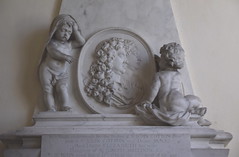 |
|
An elusive church,
difficult to pin down, difficult to find and
difficult of access. For a start, St Nicholas
isn't a parish church at all. It sits beside the
remains of Landwade Hall, which was partly
destroyed by a German bomb during the Second
World War. Pevsner isn't very kind about the bit
that was left, but it looks lovely to me. The
Landwade Hall estate was part of the parish of
Fordham in Cambridgeshire, but the church had
long been a chapel of ease for the parish of
Exning in Suffolk.
Exning and the part of Newmarket north of the
town centre were an island of Suffolk within the
county of Cambridgeshire until as recently as
1895, when the Cambridgeshire parish of Newmarket
All Saints was moved into Suffolk to join the two
bits together. One of the options at the time of
the revision of English Counties in 1974 was to
move Newmarket and Exning completely into
Cambridgeshire. However, this was voted down in a
local referendum, and Newmarket and Exning remain
semi-detached parts of Suffolk. The corridor
connecting them is only a hundred yards wide.
|
A further attempt to tidy up the
border between the two counties came in 1994. The changes
affected a number of parishes, but the amount of land
changing hands in each case was actually very small. In
total, two people were moved from Suffolk into
Cambridgeshire, and ten people came the other way. These
were all living in the former grounds of Landwade Hall,
and with them came their church.
One of the curiosities here is that you can sense the
border, new as it is. Landwade Hall is secret and wooded,
you can hear the call of pheasants and the impatient
whinny of horses in the adjacent paddock. Back on the
road, you cross the railway bridge into Cambridgeshire
and are immediately confronted with the vast Turners
distribution warehouses, and beyond them the nightmarish
A11 and A14. No county in the British Isles has been
affected so much by human habitation as Cambridgeshire.
92% of the land area is under buildings, industry or
farming. Of the remaining 8%, hardly any of it is covered
by trees, since Cambridgeshire is also the least wooded
county in Britain. Even Greater Manchester and the West
Midlands have more wild areas. Cambridgeshire is even
less wooded now that it has lost Landwade.
The lane through the woods up to the cottages is not
sign-posted, apart from one reminding Turners' drivers
that it wouldn't be a terribly good idea to go up there,
and when you get up to the cottages the driveway to the
Hall is also not signposted. From this point you are on a
private road without a public right of way. There is,
however, a public footpath which runs up to the church
from the road. This leaves the main road about 100m
further north of the lane to the cottages. Beside it is
the former gatehouse, but I am told that the gate there
is quite often locked.
Reaching the Hall is like stepping out of time. The
church sits behind the Hall, you are on private land, and
at this point it is worth saying that St Nicholas church
is in private ownership. This is an unusual state of
affairs, but not unique - in Suffolk the same is true of
the Estate churches at Ickworth and Hengrave. For
centuries, Landwade Hall was the home of the Cotton
family, and that is why you will want to come here, for
the church is also their mausoleum.
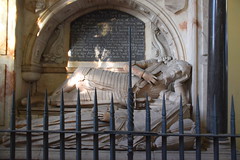   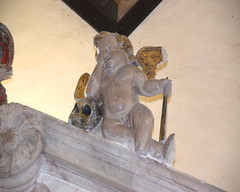
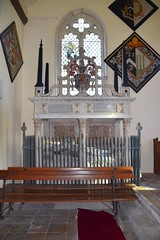 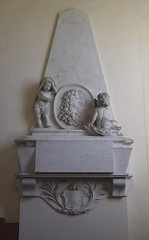 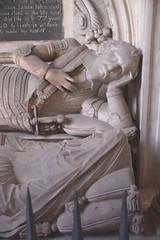 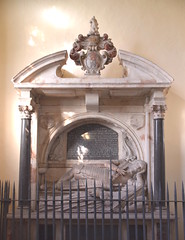 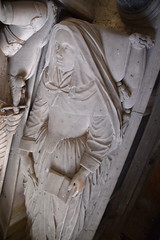
The exterior of the
church is not particularly pretty, since it has been
cemented over, but it is interesting as an example of a
small church that was all built in one go. It dates from
the mid-15th century, but is not ennobled with a
clerestory and nave aisles like its contemporary at
Denston. The window tracery is Perpendicular, but that is
about it.
The church is kept locked, but if you can gain access you
step into an open, light, aisleless space. A small image
niche is set beside the opposite door. There are some
15th century benches which must have been installed when
the church was built. The rood screen retains its rood
beam, and rises full length to it. However, it is hard to
see where a rood loft might have been, and there is no
surviving evidence of a stairway up to it. Indeed,
because there are two chancel aisles, it is strung
between two pillars. Further, there is very little
clearance space between the rood beam and the ceiling.
The nave windows contain a sequence of heraldic shields
commemorating the various marriages of the Cottons.
Several also have good 15th century figures in them, and
there are more in the chancel aisles. None are complete,
and there must once have been more, but they are rather
striking in their surroundings of clear glass. The only
modern glass is Francis Spear's east window, a 1966
depiction of St Nicholas calming the waters from a boat,
with a barrel full of children at his feet.
 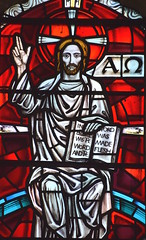 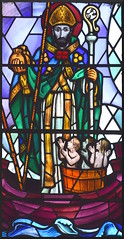
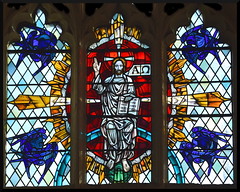 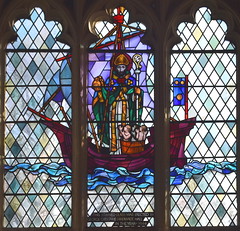 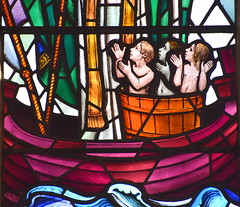
All this provides the setting for
the Cotton memorials, some of the best in Suffolk. They
are in the chancel and in the chancel aisles. In the
south aisle is the biggest, to Sir John Cotton, who died
1620. His inscription reads: Here lyeth the bodye of
Sir John Cotton knight the son and heire of Sir John
Cotton he married three wives the first Elizabeth
daughter to Sir Thomas Carrell esq of Warneham in Sussex,
the second Elizabeth daughter to Sir Humfrey Bradburne
knight of Bradburne in the county of Darby, by whome he
had noe issue, the third was Anne daughter to Sir Richard
Haughton Baronet of Haughton Towre in the county of
Lancaster by whom he had issue, James, John and
Katherine, which James and Katherine died in the life
time of there father, he departed this life in the 77th
year of his age Anno Domini 1620 and lieth in a vault in
the south ile of this church made by himself.
Sir John lies in front of it with
one of his wives, presumably Anne. The monument is
surrounded by its original iron railings, as is the one
to its right to Sir John Cotton of 1689, presumably the
son of the first Sir John, given that he must have been
quite old by the time he married his third wife. Given
that the two monuments are from either side of the
Commonwealth, they are surprisingly similar. A third Sir
John, who died in 1712, is quite different, being very
white and classical.
In the north aisle, there
is a grand six-poster memorial to a still earlier
Sir John, who died in 1593. There are other
memorials here too, but like those in the chancel
they have mostly lost their inscriptions. The
most striking chancel memorial is the long altar
tomb endways on to the east, as at Burgate. You
have to keep your wits about you so that you
don't fall over it. There is also a brass
inscription in the chancel, in the south east
corner to another Cotton, this one for a change
called William.
Perhaps most memorable for me on this beautiful
sunny day in February 2018 was the vast sea of
snowdrops and aconites sprawling across the
grounds of Landwade Hall, probably the most
spectacular display of them that I have ever
seen. |
|
 |
Simon
Knott, March 2018
|
|
|

